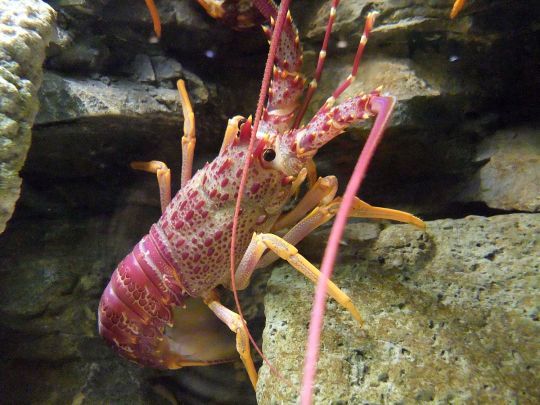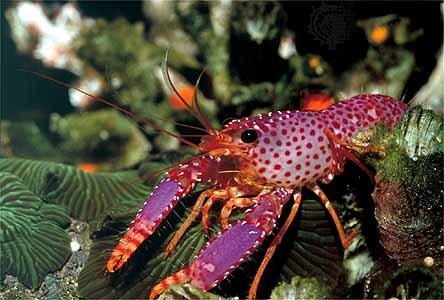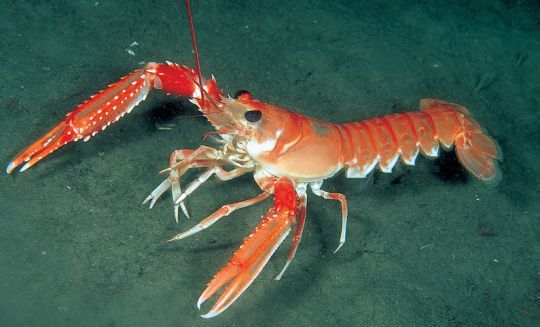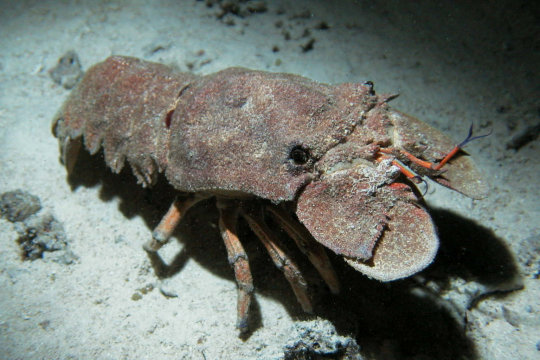#Enoplometopus
Text

A dwarf reef lobster (Enoplometopus antillensis) off the coast of Bonaire, Caribbean
by Gérard Cachon
#dwarf reef lobster#lobsters#crustaceans#enoplometopus antillensis#enoplometopus#Enoplometopidae#decapoda#malacostraca#arthropoda#wildlife: bonaire#wildlife: south america
252 notes
·
View notes
Note
Do you have any lobsters? My friend loves lobsters
DO I HAVE ANY LOBSTERS?!?!
I HAVE SO MANY LOBSTERS...
Let me show you... Here, let's have a look at lobsters from 3 different taxonomic groups...
SPINY LOBSTERS (family Palinuridae)

Southern Rock (Spiny) Lobster (Jasus edwardsii), family Palinuridae, found in coastal areas around Australia and New Zealand
photograph by Stemonitis

Ornate Rock Lobster (Panulirus ornatus), family Palinuridae, Fly Point, Port Stephens, NSW, Australia
photograph by Richard Ling

California Spiny Lobster (Panulirus interruptus), family Palinuridae, off the coast of California, USA
photograph by Brett Seymour | NPS
REEF LOBSTERS (family Enoplometopidae)

Violet-spotted Reef Lobster (Enoplometopus debelius), family Enoplometopidae, found around the Pacific Ocean
photograph by reef-guardian.com

Atlantic Reef Lobster (Enoplometopus antillensis), family Enoplometopidae, found in warmer parts of the Atlantic Ocean
photograph by Fernando Herranz Martín

Hawaiian Red Reef Lobster (Enoplometopus occidentalis), family Enoplometopidae, Hawaii
This species is normally red, but this individual has just molted.
photograph by Drew R. Smith
TRUE or TYPICAL LOBSTERS (family Nephropidae)

European Lobster (Homarus gammarus), family Nephropidae, found in the eastern Atlantic
photograph by H. Zell

American Lobster (Homarus americanus), family Nephropidae, found off the Atlantic coast of the NE U.S. and eastern Canada
photograph via: University of Maine
#lobster#decapod#crustacean#spiny lobster#reef lobster#ocean#homarus#nephropidae#Enoplometopus#Enoplometopus occidentalis)#family Enoplometopidae#Panulirus#palinuridae#jasus#aniamls#nature
445 notes
·
View notes
Video
Fiery flame lobster by Gérard Cachon
Via Flickr:
Flame lobsters (Enoplometopus antillensis) are very hard to find, especially during the day (as in maybe 1 every 150 dives). When you have the rare occasion to find one, they either are tucked too deep into the coral to get an image or immediately crawl into an inaccessible spot, giving you only a brief glimpse. But this one fortunately chose a relatively shallow crack with a sufficiently wide opening. It tried to back away, but it "ran" into a wall, allowing a clean shot and at eye-level as an added bonus. In short, I doubt I will get an image of another flame lobster that I like better. They are apparently prized in the aquarium trade because of their bright color and small size (they are about 10cm long). I prefer to see them in the wild. They are a thrill to find and incredibly beautiful with their bright red and white streaks. (A red lobster that hasn't been cooked!)
#Bas#Bonaire#Lac Cai#flame#lobster#Enoplometopus antillensis#dwarf reef lobster#Atlantic reef lobster#flaming reef lobster#reef#coral#dive#diving#scuba#Caribbean#shore#ocean#sea#water#adventure#macro#small#red#colorful#unusual#rare#marine#creature#claws#100mm
4 notes
·
View notes
Text




This is the good night post! Some photos of reef lobsters (genus Enoplometopus)! I love them very much, they are so pretty!
Also, trying to go over crustacean classifications, and these are so very confusing, but I’ve discovered so many cool species! I totally didn’t know horseshoe shrimp (class cephalocarida) were a thing!! These primitive guys (12 known species apparently) live in intertidal zones down to about 1500m deep and have no eyes! They feed by filtering food particles with their legs!

#🦞chat#cephalocarida#enoplometopus#lobster#shrimp#but not actually hahahahah#crustaceans#the good night post#📗coolthingcompilation#also. salmon art coming out soon#hehehhehehehhehehehehhehehehehehehehee#i’m tired#marine biology
10 notes
·
View notes
Note
Thoughts on lobsters? I really like them, especially Norwegian, squat, and reef lobsters (:
Lobsters are some really funky creatures, I love them.

^ Enoplometopus or Reef Lobster
1. As far as we know, lobsters don't stop growing. They don't live forever, like some people say, but they never stop growing! (Although under the right circumstances, they can live for a long time- the oldest known lobster was 140 years old!)
2. They will eat each other. This is actually a reason why lobster farms aren't really a thing- the enclosed lobsters will literally eat each other.

^ Nephrops norvegicus or Norwegian Lobster
3. Lobsters have a gastric mill, which is sort of like teeth in the stomach. This is how lobsters and many other invertebrates chew their food. The teeth-like fixtures grind it up in the stomach.
4. They do have some regenerative powers. It takes a while, usually up to a few years, but they can regrow claws.

^ Scyllaridae or Slipper Lobsters (my favorite family of lobsters)
5. Lobsters have a dominant claw, kinda like people. They can also be ambidextrous.
6. Lobster blood is colorless until it’s exposed to oxygen, then it becomes blue!
#marine bio#marine life#marine creatures#marine ecology#marine biology#marine science#lobsters#lobster#crustacean#crustaceans#animals#animal facts#ocean#oceans#sea#sea creatures#sea animals#sea creature#sea animal#biology#science#ecology#zoology#icthyology#nature#wildlife#fun facts#Earth#conservation#reef lobster
463 notes
·
View notes
Photo

Freshly molted Hawaiian Red Reef Lobster, Enoplometopus occidentalis, on display at the Waikiki Aquarium.
The red coloration will emerge in a few hours, after molting.
photograph: Drew R. Smith | Wikipedia CC
71 notes
·
View notes
Photo

Violet-spotted Reef Lobster (Enoplometopus debelius)
4 notes
·
View notes
Photo

Researchers have just discovered a new hermit crab species!! Named Candy striped hermit crab (Pylopaguropsis mollymullerae), this species is described based on specimens from the shallow reefs of Bonaire, Lesser Antilles, southern Caribbean Sea. The description it was release in the january issue of zookeys.
Populations of this new species were discovered and photographed in the Bonaire National Marine Park under a large coral ledge, at a depth of 13.7 m, living in crevices close to flaming reef lobsters (Enoplometopus antillensis), and broad banded moray (Channomuraena vittata).

The highly visible color pattern of bright red stripes on white background typical of decapods known to have cleaning symbioses with fish, dense hair-like setaes on antennae, and preference for a crevicular habitat, combined with brief in situ nocturnal observations, suggests the possibility that Candy striped hermit crab engages in “cleaner” activities or functions as a “den commensal” with moray eels.

- In situ video of Pylopaguropsis mollymullerae
Reference (Open Access): Lemaitre. 2017. Discovery of A New Species of Hermit Crab of the Genus Pylopaguropsis Alcock, 1905 from the Caribbean: “Den Commensal” or “Cleaner”? (Crustacea, Anomura, Paguridae). ZooKeys.
#Pylopaguropsis mollymullerae#paguridae#crustacea#anomura#pylopaguropsis#new species#animals#science#marine biology#Channomuraena vittata#Enoplometopus antillensis#flaming reef lobsters#broad banded moray#Achelous sebae#southern Caribbean Sea#biology#biodiversity#marine biodiversity
197 notes
·
View notes
Photo

Mah Jongg Tile Set Description
Tile Set Name: FISHES.TIL
Subject: Tropical Fishes of the world
Created by: Ron Gemeinhardt
Description:
As any aquarium hobbyist or occasional pet-shop browser knows, there is no
shortage of color among the denizens of the world's oceans, rivers and other
bodies of water. This tile set is composed of common (and not so common)
aquarium dwellers--both freshwater and marine; vertebrates and invertebrates.
This set uses a direct-replacement scheme of tile substitution. Each suit in
the traditional Mah Jongg tile set has been replaced by a new suit, as
follows:
Freshwater fishes of Asia (replaces suit of dots; *=brackish water species):
1) Clown loach (Botia macracantha)
2) Red-tailed shark (Labeo bicolor)
3) Tiger barb (Capoeta tetrazona)
4) Black ruby barb (Puntius nigrofasciatus)
5) Archer fish (Toxotes jaculator) *
6) Mono (or Malayan angel) (Monodactylus argenteus) *
7) Pearl gourami (Trichogaster leeri)
8) Dwarf gourami (Colisa lalia)
9) Siamese fighting fish (Betta splendens)
Freshwater fishes of the Americas (replaces suit of bamboo):
11) Fancy guppy (Poecilia reticulata)
12) Angelfish (Pterophyllum scalare)
13) Firemouth (Cichlasoma meeki)
14) Tiger oscar (Astronotus ocellatus)
15) Neon tetra (Paracheirodon innesi)
16) Marbled hatchetfish (Carnegiella strigata)
17) Heckel discus (Symphysodon discus discus)
18) Green severum (Cichlasoma severum)
19) Dwarf gold ram (Microgeophagus ramerizi)
Coral reef fishes (replaces suit of characters):
21) Common clown (Amphiprion ocellaris)
22) Yellow tang (Zebrasoma flavescens)
23) Long-nosed butterflyfish (Forcipiger flavissimus)
24) Oriole angel (Centropyge bicolor)
25) Flame angel (Centropyge loriculus)
26) Blue devil (Pomacentrus coeruleus)
27) Regal tang (Paracanthurus hepatus)
28) Royal gramma (Gramma loreto)
29) Picasso triggerfish (Rhinecanthus aculeatus)
Miscellaneous aquarium dwellers (replace dragons):
10) Mystery snail (???)
20) Water flea (Daphnia sp.)
30) Florida seahorse (Hippocampus hudsonius)
Tropical invertebrates (higher orders; replace winds):
31) Hermit crab (Dardanus megistos)
32) Starfish (???)
33) Chambered nautilus (Nautilus pompilius)
34) Lobster (Enoplometopus occidentalis)
Tropical invertebrates (lower orders; replace seasons):
35) Nudibranch (Glossodoris sp.)
36) Sea fan (gorgon) (Gorgonarie acanthomuricea)
37) Featherduster worm (Sabella sp.)
38) Pipe organ coral (Tubipora musica)
Freshwater tropical plants (replace flowers):
39) Amazon sword (Echinodorus sp.)
40) Madagascar lace (Aponogeton madagascariensis)
41) Jungle val (Vallisneria americana)
42) Cryptocoryne (Cryptocoryne sp.)
Important note: To help you identify which tiles belong to these last two
suits, each has a common "ocean/river floor" color for all four tiles. The
plants are on a muddy brown bottom; the invertebrates rest on a dark gray
"coral sand" floor.
The notation ??? means no particular genus is represented. As for the
chambered nautilus--OK, so you'll NEVER see one in an aquarium, but it is a
pretty little beastie, isn't it?
(Incidentally, if you look carefully, you'll notice only the dwarf gourami,
pearl gourami and betta are blowing bubbles. These three fishes are able to
obtain oxygen from air as well as water--hence the bubbles.)
Some notes on legibility:
These tiles use cyan as the base color, rather than light gray, which may make
the default mouse cursor a bit hard to see. A bright cyan mouse cursor (color
number 11) works very well, and a black background (color 0) also improves the
display's appearance quite a bit. Also, since some of the fishes have rather
long names, the lettering on the tile faces is designed to minimize fatigue
and eyestrain, at the expense of a uniform character set.
125 notes
·
View notes
Photo


Hot Pants and Enoplometopus debelius for @gutter-guy!!
98 notes
·
View notes
Photo

Shrimp (Enoplometopus sp.) in Anilao - Batangas - Philippines By @paul_tuazon using Nikon D800 camera and @aquaticadigital housing #scubashooters #underwaterphotography #scuba #diving #buceo #plongee #tauchen #closeup #shrimp #philippines #marinelife #photooftheday — view on Instagram http://bit.ly/2WVYQaX
0 notes
Photo

A red reef lobster (Enoplometopus occidentalis) off the coast of Kona, Hawaii, USA
by Pierrette Wagner
#red reef lobster#reef lobsters#lobsters#crustaceans#Enoplometopus occidentalis#Enoplometopus#decapoda#Malacostraca#crustacea#arthropoda#wildlife: hawaii#wildlife: usa
438 notes
·
View notes
Photo


Finished, edited lobster and a WIP shot of the watercolors before he was done being painted. When I started the painting I just really wanted a red lobster to go with my other desk lobsters, and when I looked up “lobsters that are red” they’re all cooked! Of course now that he is finished I still really want to draw an actual red lobster.. perhaps enoplometopus holthuisi!
1 note
·
View note
Text
Hawaiian Reef Lobster
A Peaceful and Intriguing Lobster From the Indo-Pacific – The Hawaiian Reef Lobster Referred to by scientists as Enoplometopus occidentalis, the Hawaiian reef lobster is a type of small lobster classified in the genus Enoplometopus. It is brightly colored, active and commonly found at a great... https://www.withinthesea.com/invertebrates/arthropods/crustaceans/lobsters/hawaiian-reef-lobster/
0 notes
Text
Tweeted
Shrimp (Enoplometopus sp.) in Anilao - Batangas - Philippines
By @paul_tuazon using Nikon D800 camera and @aquaticadigital housing #scubashooters #underwaterphotography #scuba #diving #buceo #plongee #tauchen #closeup #shrimp #philippines #marinelife #… https://t.co/umVtpv2iMi pic.twitter.com/gxwMPLRogn
— Habu69 (@mariner3069) May 20, 2019
0 notes